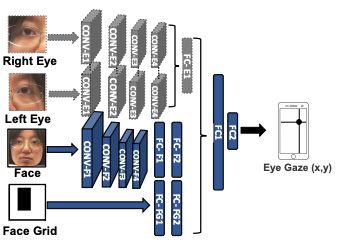
Hsin-Yu Lai, Gladynel Saavedra-Pena, Student Member, Charles G. Sodini, Vivienne Sze, Thomas Heldt
doi: 10.1109/EMBC.2018.8512281
Abstract:
Accurate quantification of neurodegenerative disease progression is an ongoing challenge that complicates efforts to understand and treat these conditions. Clinical studies have shown that eye movement features may serve as objective biomarkers to support diagnosis and tracking of disease progression. Here, we demonstrate that saccade latency – an eye movement measure of reaction time – can be measured robustly outside of the clinical environment with a smartphone camera. Methods: To enable tracking of saccade latency in large cohorts of patients and control subjects, we combined a deep convolutional neural network for gaze estimation with a modelbased approach for saccade onset determination that provides automated signal-quality quantification and artifact rejection. Results: Simultaneous recordings with a smartphone and a highspeed camera resulted in negligible differences in saccade latency distributions. Furthermore, we demonstrated that the constraint of chinrest support can be removed when recording healthy subjects. Repeat smartphone-based measurements of saccade latency in eleven self-reported healthy subjects resulted in an intraclass correlation coefficient of 0.76, showing our approach has good to excellent test-retest reliability. Additionally, we conducted over 19,000 saccade latency measurements in 29 self-reported healthy subjects and observed significant intra- and inter-subject variability, which highlights the importance of individualized tracking. Lastly, we showed that with around 65 measurements we can estimate mean saccade latency to within less-than-10- ms precision, which takes within four minutes with our setup. Conclusion and Significance: By enabling repeat measurements of saccade latency and its distribution in individual subjects, our framework opens the possibility of quantifying patient state on a finer timescale in a broader population than previously possible.
